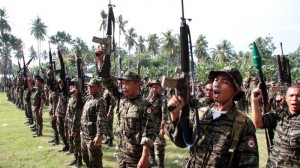Power-sharing central to Moro self-rule
(First of two parts)
With the signing of the Comprehensive Agreement on the Bangsamoro Thursday, the Moro Islamic Liberation Front (MILF) is abandoning its armed struggle for an independent Muslim state in Mindanao.
For the rest of the country and perhaps the world, this is the heart of the peace process with the Moro rebels.
In exchange, the government is committing to redo a 37-year autonomy experiment whose current version, the Autonomous Region in Muslim Mindanao (ARMM), has failed to live up to the Moro people’s aspiration for freedom from an overly centralized government.
The establishment of the Bangsamoro, which has an asymmetrical relationship with the central government, is deemed the remedy for a defective autonomy.
For the MILF and its supporters, this is the crowning glory of their four-decade struggle.
Article continues after this advertisementMILF chief Murad Ebrahim has said that even ordinary Moros consider the present instrumentalities of the Philippine state—its agencies and local governments—that they deal with every day as a “government of the aliens.”
Article continues after this advertisement17 years of negotiating
After four decades of war over the question of freedom, peace in Mindanao is bought with the grant of greater leeway for the Moro people to decide for themselves.
The historic moment in Malacañang comes after more than 17 years of political negotiations, the last 13 years of which involved neighboring Malaysia as a third-party facilitator.
This breakthrough also comes more than 17 years after the government signed a peace pact with the Moro National Liberation Front (MNLF), the original group from which the MILF broke away in 1984.
The government is confident that the Bangsamoro accord embodies most of the measures that adequately deal with Moro political demands. Hence, its negotiations with the MILF will be the last of such processes.
First, it talked peace with the rebels more than 39 years ago, through the undivided MNLF. The meeting took place on Jan. 18, 1975, in Jeddah, Saudi Arabia, under the auspices of the Organization of the Islamic Conference, now the Organization of Islamic Cooperation (OIC), according to the book “Bangsamoro: A Nation Under Endless Tyranny.”
Embrace democratic ways
As a sign of embracing democratic means to pursue its political goals, the MILF has agreed to decommission its armed wing, the Bangsamoro Islamic Armed Forces (BIAF). This will be done in phases, principally following the achievement of milestones defined in a plan for the establishment of a new autonomous region by mid-2016.
Some other conditions for the decommissioning of MILF forces are the redeployment of government security forces within Bangsamoro, establishment of the Bangsamoro police force, disbandment of private armed groups, socioeconomic development aid for former combatants, and the institution of transitional justice and reconciliation measures in a bid to straighten unjust historical narratives, correct historical injustices, and repair relations among conflict-affected communities and peoples.
“We believe that the formula we have agreed with government is the best formula that can be had. We cannot build our institutions in the context of continuing war,” said MILF chief negotiator Mohagher Iqbal, a veteran of the four-decade Moro rebellion.
Iqbal said that as previously announced, the MILF would remain a social movement while a political party will be formed as vehicle for its members’ participation in the electoral arena soon.
Redesign autonomy
In the Framework Agreement on the Bangsamoro, the preliminary accord signed on Oct. 15, 2012, the government and the MILF aimed to establish a new autonomous region encompassing predominantly Moro-populated areas in Mindanao.
The two sides concluded that the ARMM lacks the institutional attributes to effectively respond to the Moro people’s longing for self-rule. It needs to be replaced with another autonomous body imbued with far greater political and economic powers.
The ARMM continues to be dependent on economic and financial doles from the central government. Its political dynamics is largely dictated by the tenant of Malacañang; since 1989, those who have become regional governors have been anointed by the President.
The Bangsamoro will have a ministerial form of government. This feature, according to government chief negotiator Miriam Coronel-Ferrer, makes for its asymmetric relations with the central government, which follows the presidential setup in political administration.
Bangsamoro constituents will elect the members of the regional legislative assembly, envisioned to compose at least 50 representatives coming from “district, party-list, reserved seats and sectoral constituencies.”
The assembly is to be “representative of the Bangsamoro’s constituent political units, as well as non-Moro indigenous communities, women, settler communities, and other sectors.”
A chief minister will run the Bangsamoro Cabinet, to be elected by assembly members from among themselves. The chief minister will then appoint a deputy and other ministers.
The chief minister will also preside over a council of leaders composed of provincial governors, city mayors, and “a representative each of the non-Moro indigenous communities, women, settler communities and other sectors.”
Power-sharing
Central to the autonomy redesign is power-sharing. Currently, the ARMM charter lists 14 areas that are outside the powers of the regional legislature.
In the power-sharing aspect of the comprehensive peace accord, the parties came up with a list of 81 powers categorized into reserved for the central government, exclusive to the Bangsamoro and concurrent or shared by the two sides.
Of the 81 powers, 58 are devolved to the Bangsamoro, nine are reserved to the central government, and 14 are shared.
In addition, the future Bangsamoro government was given a greater share in revenues collected in the region, a greater share in income from natural wealth, and was granted authority to collect some types of taxes, all in the spirit of enhancing its fiscal capacity.
According to government panel member Senen Bacani, tax collection in the ARMM stood at P1.5 billion annually, while the regional government and its constituent local governments require P30 billion annually to operate.
RELATED STORIES
Gov’t-MILF peace pact makes history
Mindanaoans hope Bangsamoro pact will be the ‘real deal’ for peace

